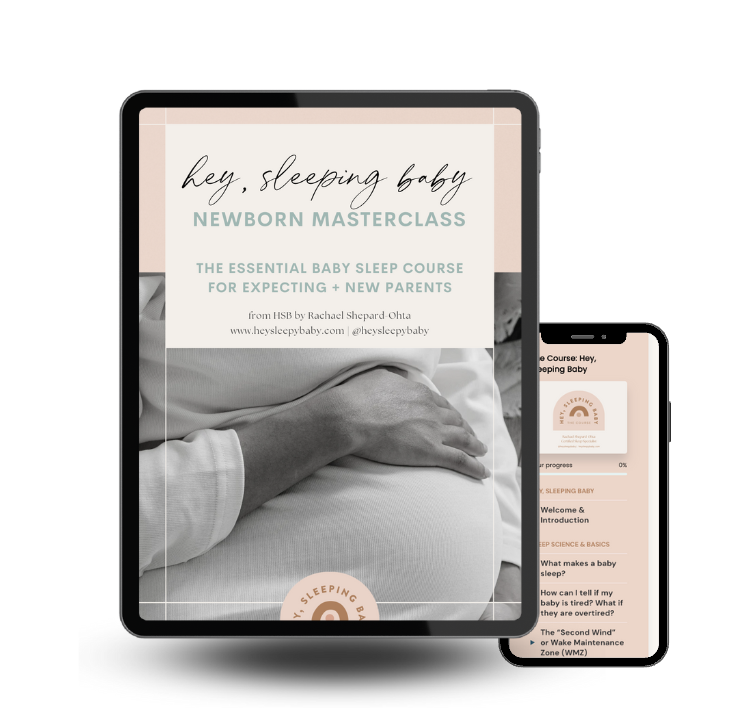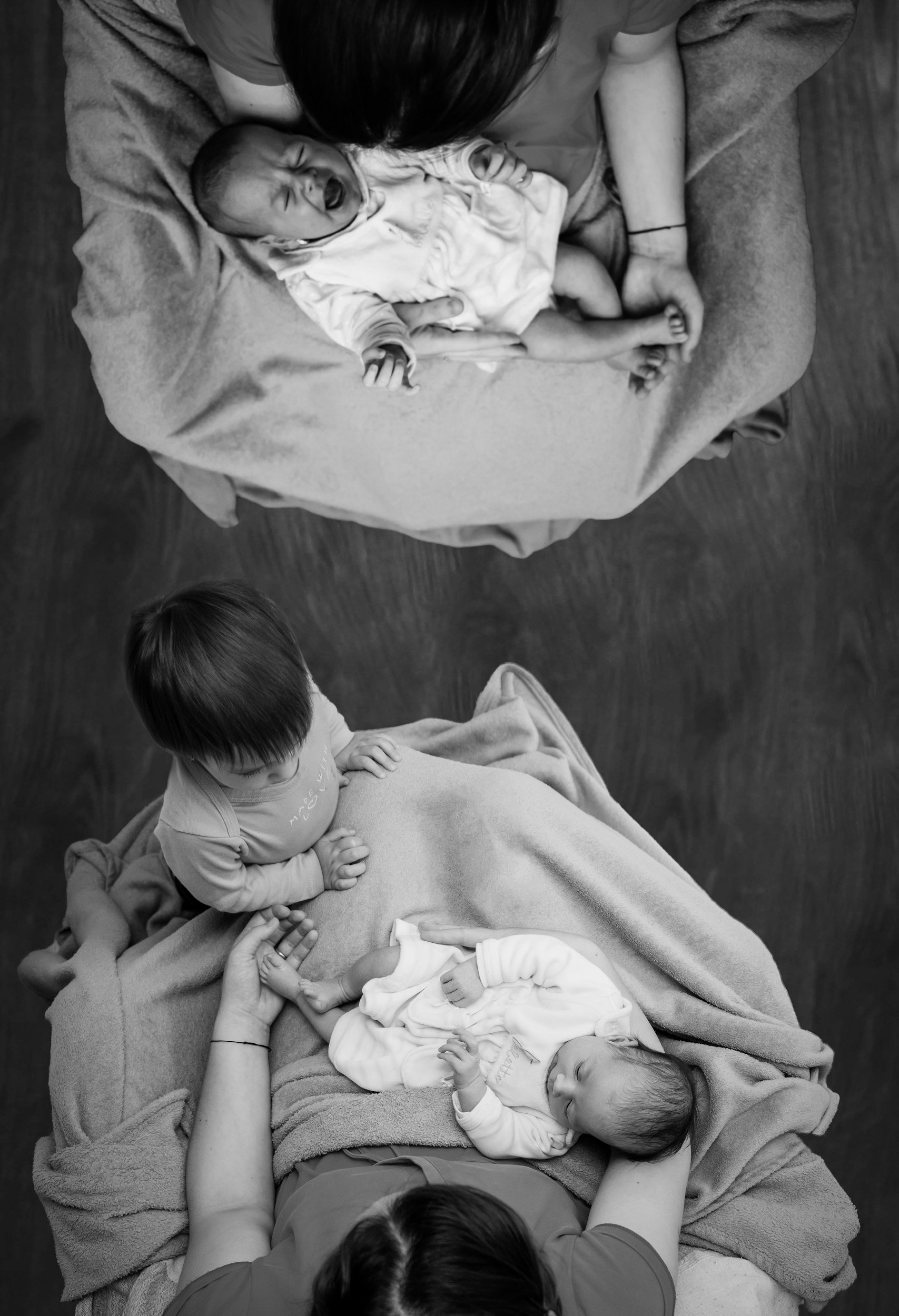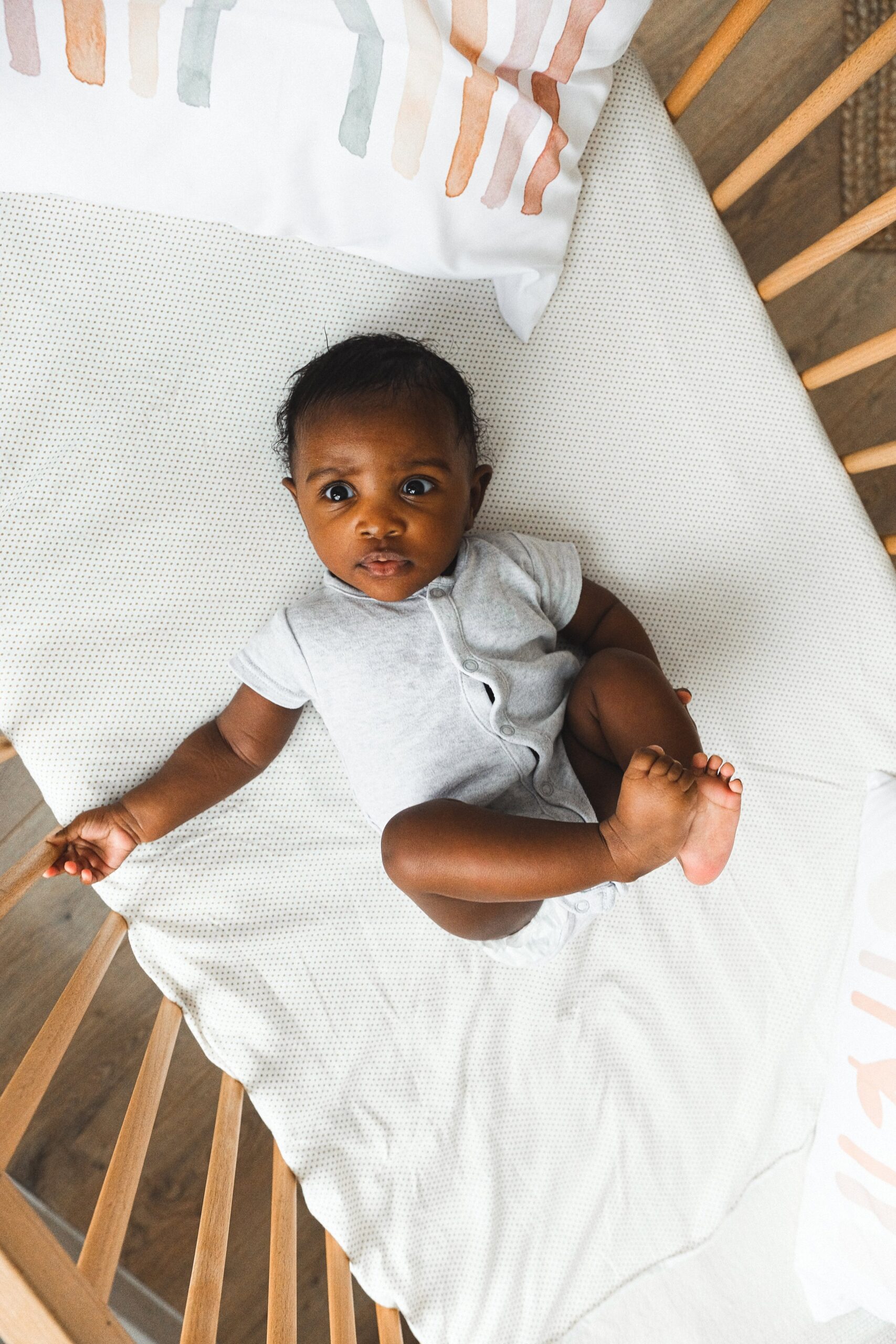I'm Rachael
Mom of 3 & Baby Sleep Expert with Big Sis Energy
& I’VE DONE ALL THE RESEARCH FOR YOU ALREADY.
Better sleep for the entire family
BROWSE COURSES
hey!
making changes to sleep and how to end sleep associations
August 17, 2023
in this post:
Most parents get to a point where their current method of supporting baby’s sleep stops working. Perhaps you want to switch things up in your bedtime routine, or you want to change what you use to help your baby to sleep. Whatever your reason for wanting to change up the sleep associations, these are my quick tips for making gentle changes without any need for sleep training.
This can be tricky, since most of the time the parents are ready to change the sleep association but the infant is very attached to the current situation! The idea of change can seem daunting and leaves you wondering whether you will ever sleep again or if your baby will ever fall asleep without you. Keep reading to see what I recommend for making gentle changes to your current sleep set up!

what are sleep associations?
Sleep associations are the strong connections that babies make with sleep. These can be things like nursing, rocking, bouncing, singing, patting, white noise, etc. There are several reasons you may want, or need to, introduce replacement sleep associations.
what’s your goal with making a change?
The first thing to do is to be clear about your goal. Why are you making the change, what change is it you want to make, when do you want to do it, and how. Being clear about your aim helps you to navigate through the transition period. Maybe you want to stop nursing to sleep but what are you going to use as the replacement? Or you want to stop bouncing to sleep and move to cuddling together in the bed to fall asleep. Having a clear picture and end goal allows you to fill in the steps in between.
consider the Timing
Choosing the right time to begin changing sleep associations is crucial. We will never find the perfect time but there will be optimum times to make changes. If your baby is in a sleep progression, teething, an intense phase of separation anxiety or they are sick, this is not going to be an ideal time for making a change. Similarly, if there is emotional change within the family like a return to work or a new sibling these will again be periods where I would not advise making any major changes.
Red flags need to be explored too. If your baby is waking hourly for milk and is using nursing to soothe symptoms of reflux, for example, then this would need to be resolved with an IBCLC before removing nursing as their sleep association.
Bedtime Routine
Having a strong and consistent bedtime routine is a great way of easing the transition away from a sleep association. The routine will consist of sleepy cues that signal to your baby’s brain that sleep is approaching. Doing the same routine each night means that they have this consistency even if the final part of falling asleep is about to change.
Methods I recommend to end sleep associations
Once the aim, optimum timing, and bedtime routine have been addressed, we can begin to look at how we are going to end one sleep association and begin another. There are three main ways that I teach moving on from sleep associations. These are:
-
Pause and Resume
-
Gradual Release Method
-
Habit Stacking
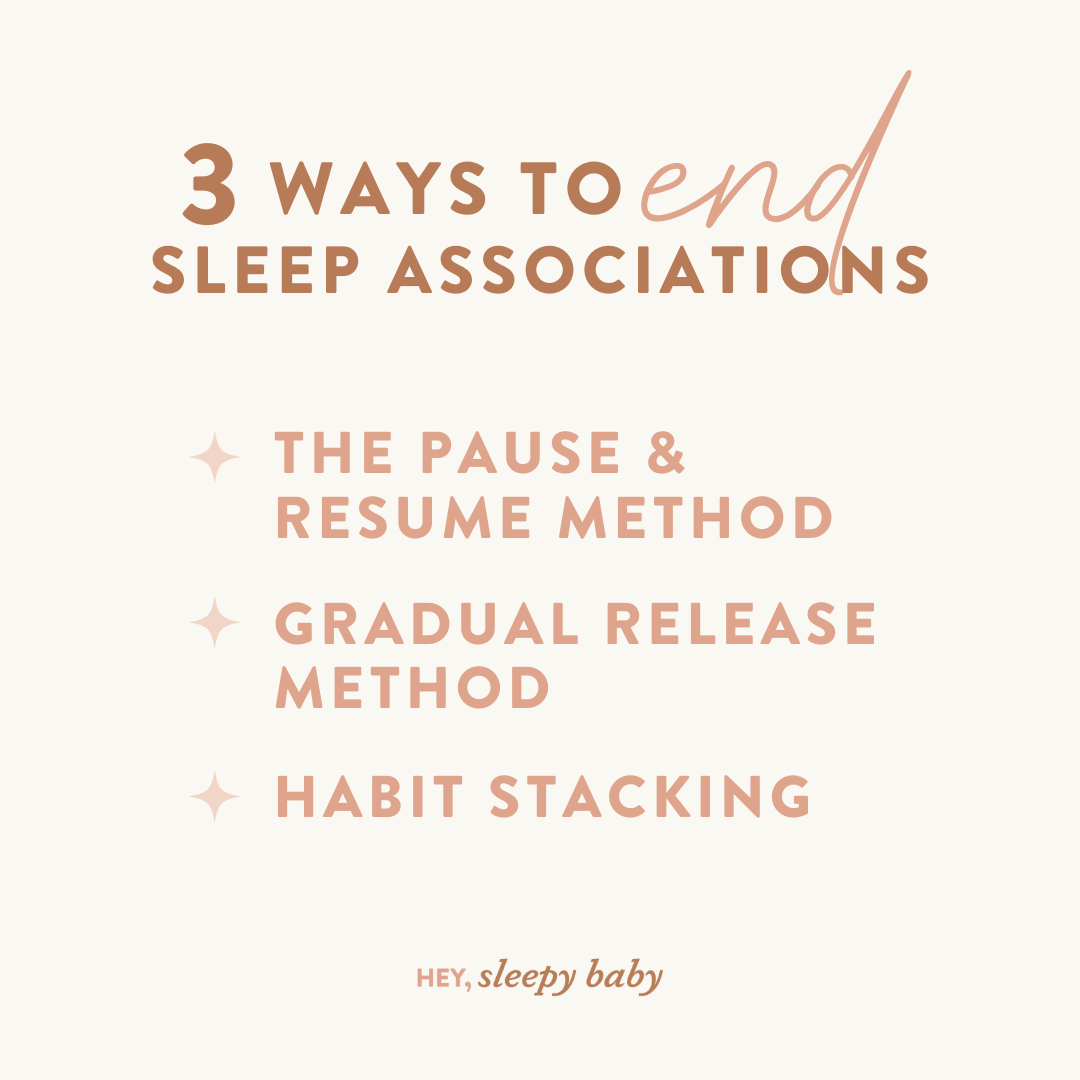
The Pause and Resume Method
This method allows babies to get used to letting go of a sleep association in manageable chunks of time. An example of how to use this method would be trying to move on from bouncing on a yoga ball. Take breaks from bouncing for increasing periods and resume when your baby becomes upset or fussy. This can start with just pausing for a few seconds! As they get used to the idea that you will begin bouncing again even though it has stopped, you can increase the gaps in between bouncing. Eventually, over time you will be able to eliminate this as a sleep association.
Gradual Release Method
This is similar to the method above but you will remove the sleep association for one or a few sleeps a day. For example, you might not nurse to sleep for one nap. Or for the initial wake-up overnight you might not feed back to sleep, or you may move the feeding to before the bath so that they fall asleep with a different method at bedtime but still feed through the night.
Habit Stacking
Lyndsey Hookway coined the term ‘habit stacking’ for the layering of these sleep associations and I like to think of them as a ladder. Infants will have ones that they more strongly associate with sleep but being able to have a range of sleep associations will make change much easier. It’s important to add in sleep associations BEFORE removing any so that your baby is already familiar with the method. So before you begin removing nursing you might want to introduce a lovey that they hold at every feed or familiar songs that you sing at bedtime and then over time remove nursing and continue with the cuddling, lovey, and songs.
supporting your child’s Emotions
It’s important to remember that your infant gains a lot of comfort from these sleep associations and they will feel frustration and sadness about letting these things go. Being able to support your infant through these big emotions is great practice for navigating the big emotions that come with toddlerhood.
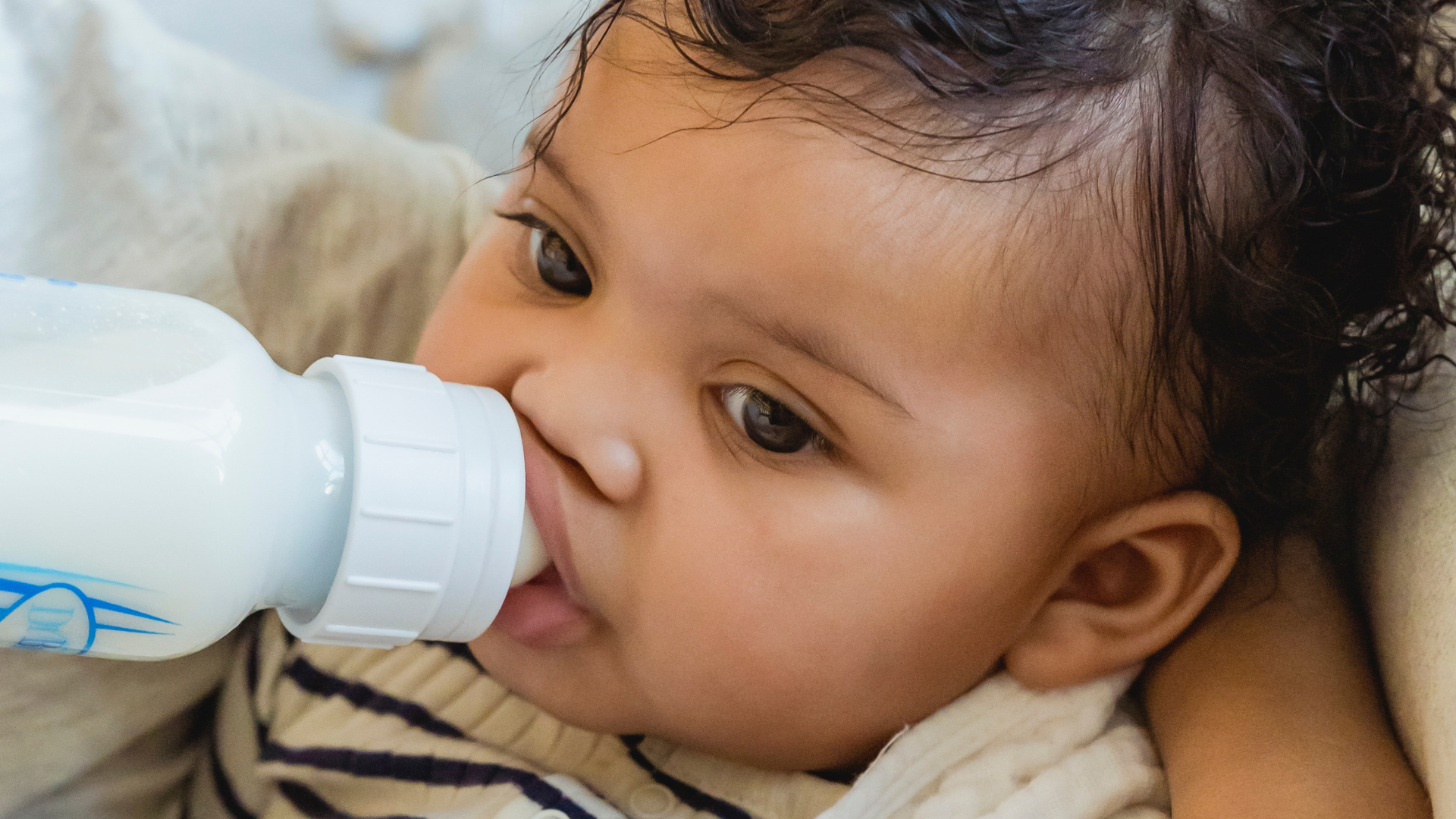
more tips on how to end sleep associations
A few extra tips for changing things up are to play a bit with your daytime routine to try and increase sleep pressure. This can help your baby fall asleep more easily with the new method! And finally depending on your baby’s temperament or sensory preferences, you may need to play around a bit with the different methods and different sleep associations until you find one that works for your family.
I really hope these tips have helped introduce you to ideas of how to make changes but if you would like a more comprehensive breakdown of these different methods and how they work in practice for each sleep association or more guidance as to which method to use for different temperaments it can all be found in my Newborn Masterclass. It’s jam-packed full of ideas, tips, advice, and more specific scenarios for making changes to your baby’s sleep! Got an older toddler or preschooler? My Better Bedtimes Guide also dives deep into making changes in a gentle way, whether you want to stop laying with your child while they fall asleep, want to stop cosleeping, etc.
Featured
What are floor beds? When to use them? And How to use them?
Before you start changing anything it’s important that you have ruled out any underlying reasons why your infant might have such a strong link to staying latched.
Was this helpful? Save it for later!

binge reads
We think you'll love these
You deserve to the
baby stage, not just "survive it."
And you DON'T have to sacrifice your values, ignore your instincts, or force yourself to follow a method you don't align with just to get your baby back to sleep.
I’m here to help you create a restful, sustainable sleep environment that honors both your baby’s needs AND your own (without the stress OR the guilt!) because, no, you don’t have to choose between the two.
enjoy!
BABY SLEEP COURSES →
BABY SLEEP CONSULTS →
Wish you could help your baby sleep better without resorting to sleep training? Download my FREE guide to a good night’s sleep and learn 8 simple, science-backed tips for supporting your child’s needs.
Traditional sleep training methods don’t have to be your solution to better sleep.
SLEEP TRAINING ISN’T THE ONLY WAY TO GET GOOD SLEEP
Hey, I'm Rachael and Hey, Sleepy Baby is for parents who want to get their nights back, without sleep training their babies.
NO ONE TOLD US POD
explorING the untold truths of parenting
